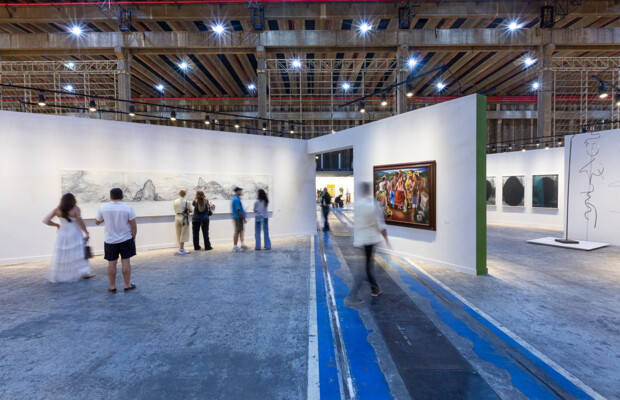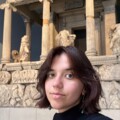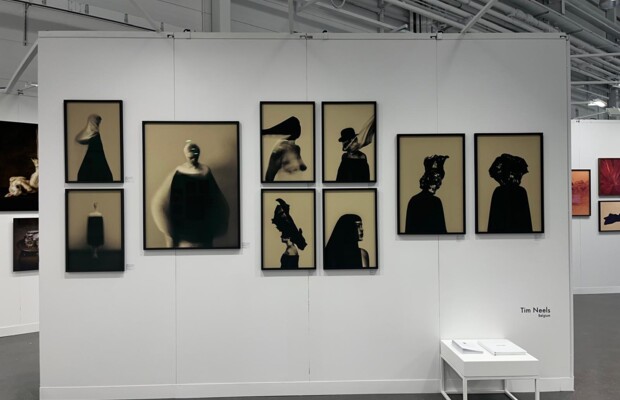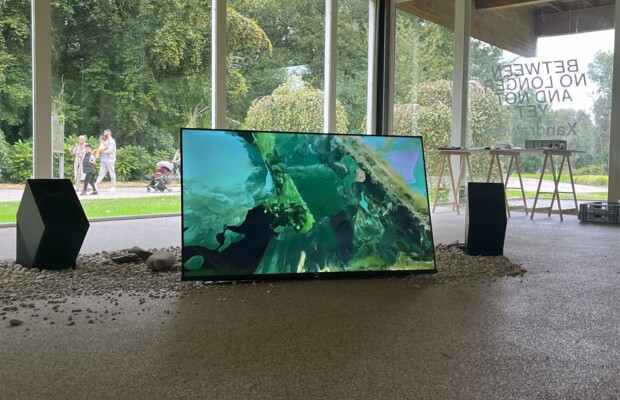Affordable Art Fair Brussels: A view from the outside

The Affordable Art Fair returned to Tour & Taxis for its 15th anniversary edition in Brussels this year, from February 7th to 11th. The fair took place in an enormous building behind the Royal Depot called the Sheds, which was brightly-lit despite the cloudiness of the day, partly thanks to its huge skylights. As I sat down in its second hall, I went through the materials I had read as preparation for my visit in my head. The art fair’s press release was titled “Lose yourself in art”, which in hindsight I realise is exactly what was about to happen to me; there was so much to see that after a few hours it was almost dizzying (in a good way!). Eighty five Belgian and international galleries were exhibiting this year, featuring the art of more than six hundred emerging and established artists. I wasn’t the only one in anticipation: I was surrounded by other journalists, and soon visitors, drinking and eating at the fair’s bar and restaurant area. Though some, like me, seemed to be enjoying alone time with a drink in hand, many had also decided to come in groups or couples. Almost everywhere I looked, people were chatting and laughing.
The white wine in my glass made me think about how the founder of Affordable Art Fair, Will Ramsay, recalled in an interview that it was the educational business approach of a wine chain in the 1980s that inspired him to “demystify art and bring it to the attention of people who did not yet know it could be very relevant to them”, thus leading him to hold the first Affordable Art Fair in Battersea, London, 25 years ago. Welcoming 15 000-20 000 visitors each year in 14 fairs around the world, the Affordable Art Fair’s mission remains “to democratise the art world and make art accessible to all” to this day.

To be honest, I'm not exactly an art connoisseur. I haven't spent years studying for an art degree, which seems to be the norm for fitting into the art scene. Thus, I can understand why someone who isn't deeply involved in the art scene or merely enjoys art casually might easily feel out of place or intimidated when entering spaces and events like this one. However, the relaxed atmosphere that the Affordable Art Fair is celebrated for was infectious: the young employee who complimented my nails when giving me my press pass and the music playing in the background, reminiscent of Cleo Sol, as I began to browse the galleries’ booths, almost made me forget why I would ever feel like an impostor for simply wanting to engage with art and others who are fascinated by it.

Overall, I noticed that the individuals I approached, or who approached me, appeared eager to discuss their experiences and knowledge of the artworld. However, some politely declined, citing concerns about their proficiency in English, which underscores the international appeal of the fair. For example, I caught an older couple right when they entered the building. My attention was drawn to their bold fashion sense: the lady was wearing a fabulous pastel-coloured, shiny bomber jacket. Daniel shared with me that their return to the Affordable Art Fair in Brussels for the past 6-7 years was driven by their enjoyment of modern art, the excitement of discovering new ideas and technologies, and an appreciation for the affordability and accessibility offered by the event.
I also got the opportunity to speak with two young women from Brussels, Léonore & Yoelq, who told me they were invited to visit because a friend’s father was exhibiting his art at the fair for the second year in a row. Although, that was not the only reason they decided to come here again on the opening night. Léonore commented that they “love it here, because there’s a lot of different styles of art, and you get to talk to artists”. They added that the artists are actually eager to talk to you, instead of interaction being initiated only by attendees.

In a conversation with Atena Abrahimia, the marketing manager of the Brussels and Amsterdam fairs, she confirmed that their leading intention is to create a fun, non-intimidating and accessible atmosphere. To achieve that, she explained that their specialties, in addition to the price cap of €10,000 for an individual piece, include ensuring that a price label is visible next to each artwork and allowing buyers to take the piece home on the same day. After these insightful conversations, I took the opportunity to immerse myself further into this atmosphere firsthand.

At the booth of Early Birds Art Gallery, my attention was immediately caught by the cardboard sculptures of Olivier Bertrand, something unlike anything I had seen before. When the gallery’s manager, Francis Dedrie, noticed my curiosity, he did not hesitate to ask if I wanted to hear the story behind the art. As I listened inquisitively, Francis explained that the artist started with traditional origami, but due to the vast availability of cardboard in his home at the time, he ended up switching to a new material. This reminded me of another section of the fair: the Spotlight on Uncommon Materials. Consisting of six booths and an interactive studio, it had been explicitly curated for this year’s fair, featuring galleries such as Gallery Ritter and A Posteriori, specifically focusing on contemporary artists with the ability to turn curious materials into something striking.

It was the first time for the Early Birds Art Gallery at Affordable Art Fair Brussels, but Francis didn’t seem nervous, despite that the gallery usually partakes in what he called higher-level fairs. He explained that February is usually quieter for sales, and the decision to attend with a range of more affordable artwork from the artists they exhibit, came after recommendations from other gallerists. Francis expressed a hope that people who visit the gallery outside of the fair wouldn’t be discouraged if they couldn’t afford a more high-end piece from their artist of interest. While such pieces are often on display, the possibility of purchasing a lower-end piece from the same artist or commissioning work is often overlooked by art lovers.
A tip from a friend about the chance to acquire more affordable art is exactly what motivated a family of three from Gent, Belgium, to make the 1-hour-long drive to Brussels that evening. As Koen and Evelien shared, their interest in art led them to visiting another fair the week before, but that night they decided to check out the Affordable Art Fair, also bringing their 10-year-old daughter Axelle, who loves painting, in hopes to inspire her and get her acquainted with creativity. Evelien mentioned that she appreciates the diversity of the art on display, although she noted a slight difference in quality among some pieces. At this years’ edition, visitors could find photography, ceramics, prints, paintings, sculptures and textiles in a variety of styles and materials.

Despite the outwardly achievement of the accessibility goal, visible through the fair’s reputation among the visitors and exhibitors I had conversations with, I was left curious about the organisers’ take on the issue of representation, particularly concerning the need for art to resonate with a broader audience, including minorities. I questioned whether true democratisation of art is possible without a deliberate focus on whose perspectives are showcased and who determines the criteria for assessing artistic quality. It is widely acknowledged that the art world remains dominated by the elite, who influence the taste and artistic merit. This creates the idea of an in-group and out-group, something that especially the younger generations seem increasingly aware and critical of, and what I imagine puts many off from even taking a peek into the artworld.

Yukari from Systema Gallery in Japan, and Marius from Gallery Paveikslai in Lithuania both told me it was the galleries’ second year at the Affordable Art Fair. They agreed that the participation is a good chance to meet existing customers, for example Lithuanians living abroad for Gallery Paveikslai, but also new ones from all over the world. Yukari expressed that attending the fair has brought a lot of awareness towards both the gallery and their artists’ work. Moreover, when asked about the criteria the gallerists used to choose which artists to exhibit at their booth this year, both told me it had come down to the prestige of the artists in their home countries. This made sense to me: if you have travelled far to showcase art, you want to show off the best. But this also makes it harder to disrupt the idea of a pre-dictated standard for what is considered quality art.
Yukari said they were showcasing traditional Japanese techniques, which she calls NEJA-ism.

Reflecting again on the interview with Will Ramsay, he has said the fair strives to “empower gallerists and artists to make a living out of art”. But, how is it decided whose art gets promoted? When I asked Atena about the curation of the fair, she recalled that they only exhibit works of living artists, and that the most important selection criteria had been originality. Other than that, it had been stated in the press release that the galleries should only exhibit “artists of merit”. According to Affordable Art Fair Brussels’ press release, the building blocks of this concept are supposed to be originality, creative identity, artistic intention and technical quality. Yet, these are some of the notions of the art world that are actively questioned by the out-group.

The importance of representation in the art world can’t be stressed enough, because at best, art could be healing collectively. Jelleke Tollenaar, responsible for relationship fundraising at the fair’s charity partner SOS Villages d’Enfants/SOS Kinderdorpen, emphasised the importance of survivors of complex trauma sharing their experiences as part of their healing journey. She elaborated on The City Jewel project, initially unveiled at the Affordable Art Fair Brussels. In collaboration with artivist, architect, and researcher Laura Nsengiyumva, this project aims to create a physical manifestation of public acknowledgment of trauma. Hundreds of colourful beads made by survivors of childhood trauma will be connected in a string, and made into a permanent installation at the Square Marguerite Duras.

At the end of the day, a range of emotions was stirring inside of me. I was able to enjoy and discuss a diverse range of artworks from myriad countries, all under the same roof. The atmosphere felt comfortable and well-organised, with a friendly community gathered together. The Affordable Art Fair Brussels is defying the expectations of what an art fair is supposed to be like in many ways, and in my view, it lived up to its good reputation. Nevertheless, I wondered whether the positive word-of-mouth is actually spreading just among an in-group of people, and what it would take to make art something truly accessible for everyone, whether they are artists, collectors, or casual art enthusiasts. As I rushed out of the Sheds towards the train station, I was confronted with a stark reminder of the ongoing work needed to democratice the art world: a young woman and man stood on the stairs leading to the fair, casually lighting cigarettes, one of them saying with a sigh, “Art people, huh…”
Share the post:














